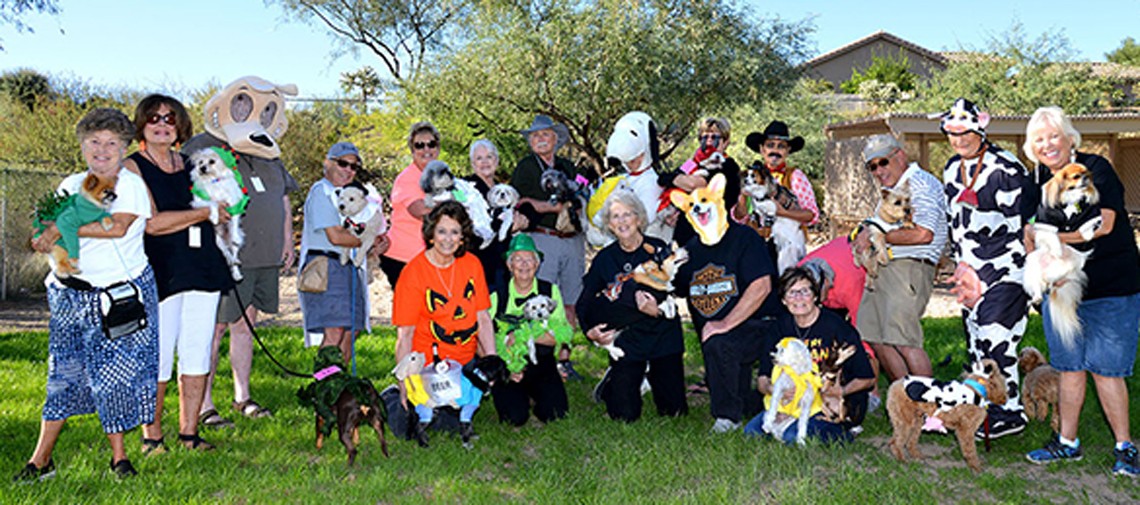
- Select a language for the TTS:
- UK English Female
- UK English Male
- US English Female
- US English Male
- Australian Female
- Australian Male
- Language selected: (auto detect) - EN
Play all audios:
TUCSON, ARIZONA Dogs can play while their owners can sit or stand nearby to watch the action. PHOTO BY ROBERT KOBLEWSKI The SADDLEBROOKE TWO RETIREMENT COMMUNITY near Tucson, Arizona, has
both a large dog park (for pups of 30 pounds or more) and a small dog park. There's a fenced area within the parks for senior dogs and shy dogs. The community has miles of sidewalks and
designated walking paths. Karen Schickedanz and her husband, Norm, both 76, were among the original visitors to the dog park when it opened in 2004. “At the time, we had a Havanese puppy
named Chica who absolutely loved going to the park to play with other pups," she says. "We now have a small, four-year-old mixed breed rescue that we're just beginning to
introduce to the park. It's important for dogs to be able to run free in safe spaces and learn how to socialize with other dogs.” Karen Brooks, 72, the dog park’s webmaster, notes that
many of the park's human visitors would never have met had it not been for the dog park. Since moving to SaddleBrooke, Brooks has had two rescue dogs. The first was Penny, an older
Poodle-Schnauzer mix. “It took five visits to the dog park during slow times for Penny to get comfortable. By the sixth visit, she was visiting every person and sitting on laps,” says
Brooks, adding that her second and current pooch, a two-year-old Cairn Terrier mix named Finnegan, "enriches my life, gives me a soul to care for, gets me out for walks, and helps me
meet other people.” REDMOND, WASHINGTON Some of S.O.D.A'.s more than 100 volunteers during an October 2022 "work party" at Marymoor Park. Photograph by Don Conrard Locally
referred to as “Doggy Disneyland," the 40-acre dog area within the 640-acre MARYMOOR PARK hosts more than a million human and canine visitors a year. The dog-designated section features
open fields, six miles of trails and a river for swimming and playing fetch. Judy and Jim Trockel have been the park’s stalwart stewards for nearly 30 years. The Trockels began advocating
for the dog park back when it was referred to as the “off-leash voice control dog area.” “DOG COMPANIONS PLAY A HUGE ROLE IN THE ABILITY OF SENIOR CITIZENS TO REMAIN CONNECTED TO SOMETHING
THAT MAKES THEM FEEL LOVED, SOMETHING THEY HAVE TO PUT FORTH THE ENERGY TO CARE FOR AND NOURISH. IT'S A QUALITY-OF-LIFE ISSUE.” _— Judy Trockel, co-founder of Serve Our Dog Areas
(S.O.D.A.) at Marymoor Park._ In 1995, when the master plan for the park was drawn up, the dog area was not part of the plan. “We fought to keep it in the park,” explains Judy. “We formed a
task force called S.O.D.A. — or Save Our Dog Areas, later changed to Serve Our Dog Areas — and lobbied the county council and parks system." Using what Judy calls “old-school” methods
of advocacy, the S.O.D.A. task force and local residents mailed more than 8,000 postcards asking the county executive to save the dog park. The work paid off with the council voting
unanimously to include a dog park. It also tasked S.O.D.A., which is now a nonprofit organization, with the responsibility for maintaining, operating and stewarding the park. “We convinced
them to recognize an off-leash dog area is a legitimate form of recreation, just like bicycling and tennis,” Judy explains. “The politics of recreational use is very competitive because
there's only so much public park land that's available, and there are all these different forms of recreation competing for it, so achieving _legitimacy_ is really, really
important.” Don Conrard (left) and Brodie Trockel staffing the volunteer sign-in table for a park work party. Sierra, Don's Siberian Husky, visits the park twice a day, rain or shine.
PHOTOGRAPH BY JUDY TROCKEL The Trockels’ passion for the park is contagious, to the tune of the 100-plus volunteers — from teenagers to senior citizens — who help with the daily maintenance
(such as picking up poop when an owner doesn’t) and large projects, such as resurfacing eight miles of trails with hog fuel, a wood byproduct that provides a soft walking surface for paws
and feet. Bill Pickard, 73, is a frequent park visitor with his two Golden Retrievers and his two grand dogs. “Parking is convenient, there’s lots of room and it's flat. My wife has hip
issues, and she can walk around the place easily because of that and the hog fuel," he explains. "The dogs can get fully tired out in one circuit. Then they go home and sleep.
When your dog is happy and relaxed, you can be too.” Patty and Don Conrard, both in their 70s, and their Siberian Husky, Sierra (pictured), are Marymoor regulars. “Huskies are strong,
high-energy, working dogs _and_ escape artists. Huskies are not a dog you can just turn loose in the backyard and forget about,” says Don. “Many of us seniors bring our dogs to the park at
about the same time every morning. It’s nice to be able to spend time talking with people my own age with similar life experiences.” Patty was particularly grateful for the park during the
pandemic. “Going to Marymoor got us through the COVID lockdowns,” she says. “It truly saved my sanity by being able to get out of the house and have some safe social interactions.” Adds Don,
“For seniors like me, owning a dog forces you to get up in the morning and leave the house and get going! It’s also great exercise.” SARASOTA, FLORIDA Two West Highland White Terriers
navigate the dog park's obstacle course. Photograph by Michelle Sayre The fenced-in dog park at ELANCÉ AT SARASOTA, a senior-living community in Sarasota, Florida, opened in 2019. It
has equipment for dogs to play on, such as a raised platform for jumping and a see-saw. Residents can also walk their dogs along nature trails on the 53 surrounding acres. The community also
offers a pet concierge service, called Leash on Life, so residents who need assistive care can continue to live with their pets. The program's services include pet walking, bathing and
feeding. According to Peggy Beasley, the community's executive director, prospective residents “love seeing that we have a dog park and are pet-friendly. Sometimes, it’s the most
important part of their decision to move in. Our sister community in St. Petersburg contacted us to ask how we built the dog park. Because of our park’s success, they built one, too.” Diana
Wilson, 72, and her husband Joe Farr, 84, are dog park regulars, along with Buddy, an 11-year-old Yorkie Poo, and Tuffy, a seven-year-old Yorkshire Terrier. “The dog park is good for
people's well-being as well as the dogs’ well-being,” says Wilson. “The goodwill benefits the whole community. It’s great socialization, and especially for elderly people who are
alone.” Farr hadn’t owned a dog since his childhood — he was too busy working —so he is relishing his time as a dog owner in his retirement. "This is kind of a first-time for me.
It's a love that you just develop," says Farr. "They're just like people, really — except with tails." RELATED LINKS A PAW PARK ON THE PRAIRIE A 2022 AARP COMMUNITY
CHALLENGE GRANT HELPED CREATE A PLACE WHERE MONTANA DOGS — ALONG WITH THEIR PEOPLE — CAN PLAY. TAKE A LOOK! ABOUT THE AUTHOR _Amy Lennard Goehner__ is a freelance reporter and writer. She is
a former staff member of _Time_ and_ Sports Illustrated_ magazines. __* The inclusion of named communities in the article "Parks for People and Pups of All Ages" is not an
endorsement by AARP._
:max_bytes(150000):strip_icc():focal(999x0:1001x2)/Billions_series-finale-102623-4-52eb196cc3934304b8c4d61e9b737a29.jpg)







